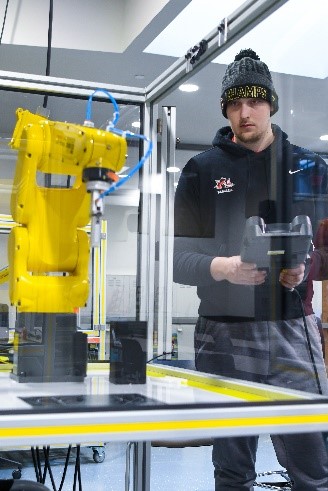Mechatronics jobs that drive the economy
As industry continues to advance through the adoption of technology and utilization of data, the need for a skilled mechatronics workforce is growing. One of the greatest needs within the evolving labor market involves building interest and participation in careers which produce the durable goods that drive local economies. Since 2.2 additional jobs are created within the supply chain and related support jobs for every 1 direct manufacturing job, the need cannot be understated (Hessman, 2015).
Despite a shortage of skilled workers, workforce productivity continues to make advances thanks to the 4th Industrial Revolution (Industry 4.0). The growing career field of mechatronics, as I referenced in my previous article; Mechatronics Education- It takes a community, is at the epicenter of these advances. The challenge however is building a pipeline into these careers. Fortunately, previous research into how people make decisions can be leveraged to help resolve the workforce shortage.
Self-efficacy
A critical concept to understand in order to help resolve workforce shortages in the mechatronics area is self-efficacy. According to Bandura (1999), for someone to engage in a specific action requires that they first think that they can be successful in the action (self-efficacy) and also have the result of their action be positive or worthwhile (outcome expectancy). Since it is easy to document the wages and career opportunities within the field of mechatronics, satisfying the outcome expectancy portion is relatively easy with proper communication. Traditional guidance or career counseling has long been focused on doing just that but with mixed results. I would argue that this is largely due to the lack of experiences provided to secondary school students within the various career fields. If one doesn’t experience it in school, how would we expect them to know it exists, know that they can be successful at it, recognize that they may be good at it, and then later select it as a goal for a career? This argument appears to be further supported when reviewing social cognitive career theory (SCCT). SCCT builds upon Bandura’s work by focusing on the variables of self-efficacy, outcome expectations, and goals and their interaction with the environmental factors in the context of career development (Lent, Hacket, & Brown, 1999). In short, it looks at how students build occupational interest. By building personal belief in one’s own capabilities related to mechatronics, we build self-efficacy and increase the likeliness of students selecting it as a career field. Providing coursework within mechatronics at the secondary schools appears to be a critical link to building a pipeline into these careers. When courses can be offered for dual credit, it further builds upon the connection to future career potential.
The need for Guided Pathways within higher education
 The career field of mechatronics is broad and sometimes confusing or even misrepresented within academia. Encompassing technical expertise crossing multiple traditional occupational programs, mechatronics programs may include information technology (IT), operational technology (OT), robotics, design, programming, data analysis, mechanical, electrical, and digital systems. With so many related yet differentiated areas of focus, identifying which courses to offer within the secondary schools can become problematic. Utilizing the guided pathway approach, colleges can effectively redesign academic programs so that individual classes may be more easily offered at secondary schools for dual credit while also allowing for the broad exposure into the multitude of individual career paths. The guided pathway concept takes similar programs within a meta-major and works to build a series of common courses within them on the front end. In essence, you create a funnel upfront and then allow students to specialize later on. By doing this, academic program classes offered at the secondary level for college credit can apply to a multitude of future academic career programs once the student moves onto college, thus building self-efficacy in many areas with minimal courses needed. Western Technical College in La Crosse, Wisconsin has found success using this model within their mechatronic education programs.
The career field of mechatronics is broad and sometimes confusing or even misrepresented within academia. Encompassing technical expertise crossing multiple traditional occupational programs, mechatronics programs may include information technology (IT), operational technology (OT), robotics, design, programming, data analysis, mechanical, electrical, and digital systems. With so many related yet differentiated areas of focus, identifying which courses to offer within the secondary schools can become problematic. Utilizing the guided pathway approach, colleges can effectively redesign academic programs so that individual classes may be more easily offered at secondary schools for dual credit while also allowing for the broad exposure into the multitude of individual career paths. The guided pathway concept takes similar programs within a meta-major and works to build a series of common courses within them on the front end. In essence, you create a funnel upfront and then allow students to specialize later on. By doing this, academic program classes offered at the secondary level for college credit can apply to a multitude of future academic career programs once the student moves onto college, thus building self-efficacy in many areas with minimal courses needed. Western Technical College in La Crosse, Wisconsin has found success using this model within their mechatronic education programs.
Western’s mechatronic programs
Through work supported by a National Science Foundation grant, and working with employers and secondary school partners, Western has been building self-efficacy and interest in mechatronics. The adoption of an introductory mechatronics, industrial controls, robotic programming, and IIOT course within four of their related academic programs has allowed for the rapid expansion of dual credit within their region. Western also provides training to secondary school teachers on all courses to ensure quality, raise awareness, and encourage further adoption at the secondary school level. Collectively, these efforts are paying dividends by ensuring the continued vitality of the local economies served.
Bandura, A. (1997). Insights. Self-efficacy. Harvard Mental Health Letter, 13(9), 4-6.
Hessman, T. (2015). America’s advanced industries: New challenges for a new manufacturing. Industry Week/IW, 264(2), 28-30.
Lent, R. W., & Brown, S. D. (1996). Social cognitive approach to career development: An overview. Career Development Quarterly, 44(4), 310.
Lent, R. W., & Hackett, G. (1999). A social cognitive view of school-to-work transition. Career Development Quarterly, 47(4), 297-311.
This material is based upon work which is supported by the National Science Foundation under grant no. 1801063. Any opinions, findings and conclusions or recommendations expressed in this material are those of the author(s) and do not necessarily reflect the views of the National Science Foundation.

For more information on the project, please contact Dr. Gamer at GamerJ@westerntc.edu








